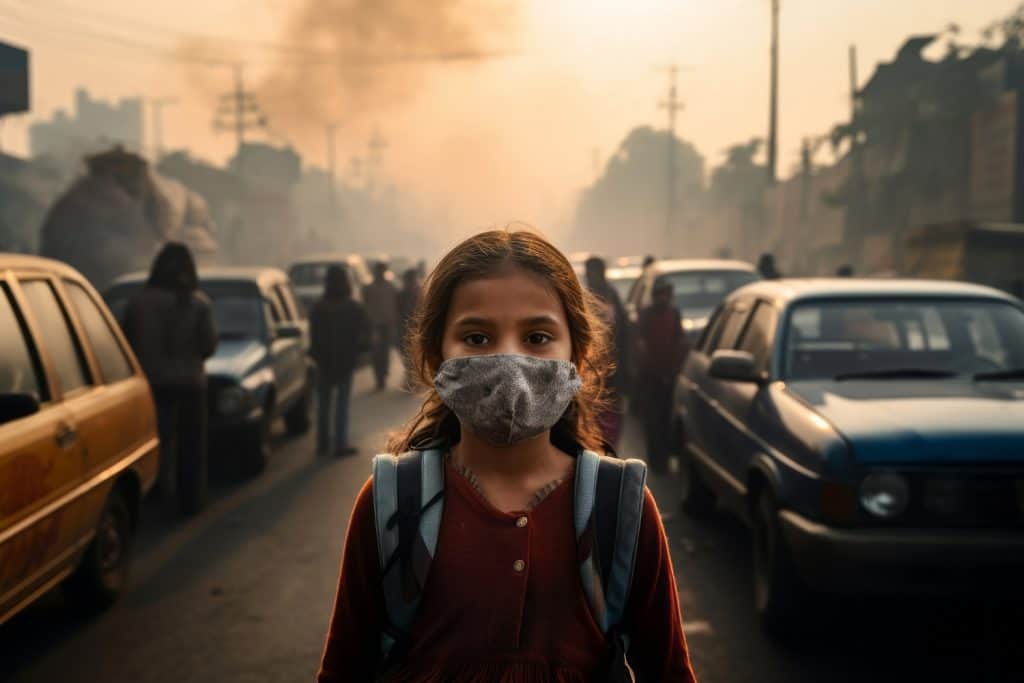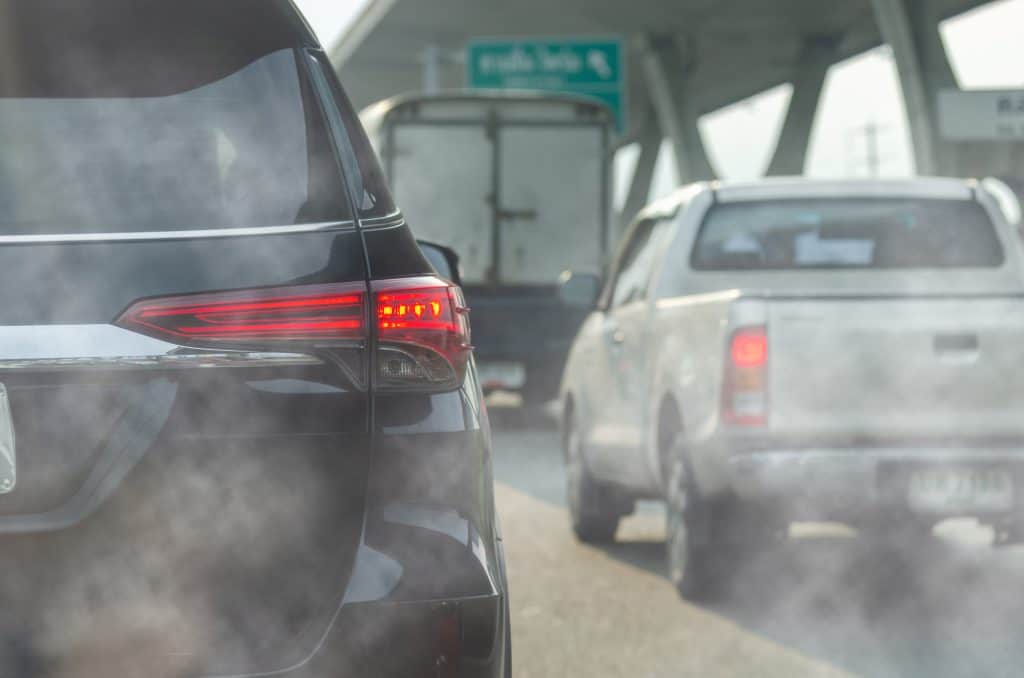
In This Article
Air pollution is an omnipresent issue in modern society, as it has a significant effect on the lives of every living thing on the planet. It is associated with a wide range of respiratory conditions, including asthma, chronic obstructive pulmonary disease (COPD), and lung cancer, which severely affect the quality of life and kill millions of individuals every single year.
Types of pollutants
The burden of diseases associated with air pollution is large and growing constantly. There is a lot of research available that show the correlation that exists between exposure to polluted air and a wide range of respiratory conditions.
Generally speaking, the most dangerous air pollutants are included in the WHO global air quality guidelines. Specifically, the main pollutants that compromise human health are articulate matter (PM), carbon monoxide (CO), ozone (O3), nitrogen dioxide (NO2) and sulfur dioxide (SO2) as health problems can occur with both short-term and long-term exposure. Additional pollutants which should be taken into consideration are lead (Lb), polycyclic aromatic hydrocarbons (PAH) and formaldehyde.
While adherence to these guidelines isn’t mandatory, they do provide WHO members with an evidence-informed tool that they can use to inform government officials and policy makers when developing strategies to reduce emissions.
Air pollution around the world
According to the World Health Organization (WHO), more than 99% of the global population are exposed to air that exceeds WHO guideline limits. This standard was established to determine the upper limit of air pollution that could be reached at any given moment to prevent health complications. However, historical data shows that for the last couple of decades, we have been unable to keep our emissions below that limit.

According to WHO public available data, around 1.3 million people died from air pollution related diseases in 2008. In 2012, that number increase up to 3.7 million deaths. In 2023, it is estimated that more than 7 million people died prematurely from exposure to air pollution. It is clear that the issue of air pollution has only gotten worse, which is why the United Nations has named it as the “the world’s worst environmental health risk” of modern times.
Air pollution is closely related to climate change, and specially human-made, as a lot of anthropogenic sources release these emissions into the atmosphere. We have industrial and agricultural facilities, mining operations, urban centers that release a lot of emission from vehicles, vans and buses, as well as landfills that release emissions from waste.
Furthermore, new data has arose that confirms that forest fires have become more widespread and frequent in the last 20 years. According to the research, forest fires now result in 3 million more hectares of tree cover loss per year compared to 2001 data. This is important, as wildfires also release harmful particles into the atmosphere and it is expected that they will continue to increase in frequency and intensity.
Regions such as East Asia, South Asia, and the Middle East bear a substantial burden, grappling with severe air pollution due to industrial activities, vehicular emissions, and biomass burning. However, no corner of the globe remains untouched. Even remote areas can experience pollution due to long-range transport of pollutants.
Existing research on adverse effects

After the publication of the first WHO air quality guidelines in 2005, a lot of research has been done detailing the adverse health effects of high levels of air pollution all over the world. Some of the key findings are explored as follows:
Vulnerabilities on our youngest
Children and teenagers are more susceptible to develop respiratory complications compared to adults. This is due to the fact that the respiratory system continues to grow in girls until their late teens and in boys until their early 20s. Unsurprisingly, age is then a major risk factor for respiratory complications caused by air pollution. Between birth and the age of 6 is when children are at their most vulnerable, as they develop more than 80% of their new alveoli following birth.
In fact, pollution exposure during prenatal development is really dangerous, as it can alter the development of both immune function and lung mechanics. This can cause debilitating lung injuries which will define subsequent immune development and increase an child’s susceptibility to allergic reactions and other pulmonary illnesses. Furthermore, smoking during pregnancy is also risky, as it has adverse effects on fetal lung development and increases the risk of the baby to develop asthma.
Fortunately, there are some studies that show how exposing children and adolescents to better air quality on the long term will improves their lung functionality and growth.
Asthma
Asthma is a chronic condition characterized by the inflammation and constriction of the airways in the lungs, making breathing more difficult. There is a lot of research that demonstrate how PM, SO2, ozone and NO2 leads not only to the inflammation of the airways, but can also reduce lung functionality even with short-term exposure. Therefore, people living in urban areas are at a much higher risk of developing asthma, as traffic and industrial activities emit these gases prominently,
Poor air quality caused by high levels of ozone (O3) has also shown not only to aggravate the symptoms of asthma, but to also be the cause of asthma development in children.
COPD
Chronic obstructive pulmonary disease (COPD), also known as emphysema or chronic bronchitis, is a chronic inflammatory lung disease that causes restricted airflow and breathing problems. People that develop COPD have difficulty breathing, cough, produce a lot of mucus and can also have wheezing. Existing research shows that COPD is commonly associated with smoking, as well as indoor pollution from biomass combustion and second-hand tobacco smoke.
COPD is a lung-disease that can be aggravated by air pollution. Long-term exposure to pollutants can accelerate the progression of COPD, leading to worsened symptoms, increased hospitalizations, and reduced quality of life for affected individuals.
If left untreated in the long-term, COPD can be life threatening. In fact, according to the United States’ CDC, COPD is the sixth leading cause of deaths in United States. In 2020, around 316,000 people died due to COPD complications, equivalent to 10.3% of the total deaths in that year.
Lung cancer
While cigarette smoking is the leading cause of lung cancer, it is not the sole cause for it. In the last few years, increasing evidence indicates that air pollution is and will continue to be a major cause for lung cancer development in the future.
A 2020 study was able to show that there is a link between outdoor ambient air pollution, particularly PM, PAH, dioxins, nitrogen oxides and sulfur containing compounds with lung cancer incidence and mortality. It also shows that the number of estimated attributable lung cancer deaths has increased by nearly 30% since 2007. In comparison, the last few years we have seen that smoking has been steadily decreasing while air pollution has increased. We need to consider that smoking won´t be the leading cause for lung cancer in the future.
Data is key to address air pollution effectively
As we have explored in this article, accurate information on air pollution exposure, mortality and TK is necessary to develop accurate and in-depth evaluation models to understand the issue of air pollution and its relation with cardiovascular related diseases. To do so, governments and institutions need as much local available data as possible, which demands a commitment from every level of government.
Ideally, every country should have access to monitoring equipment that meet with the standards established by the Data Integration Model for Air Quality (DIMAQ), a global air quality model developed by the University of Exeter and the WHO Data Integration Task Force. The model aims to integrate information from multiple countries to provide accurate estimation on air quality on a high resolution grid covering the entire world. These sorts of models are invaluable to allow organizations and policy makers to monitor air pollution in the long-term and properly evaluate the effectiveness of public and private interventions. They can also critical for improving the accuracy of health and air quality studies.
Still, developing countries might not be able to do so, as their own national priorities and available resources might limit the implementation of national-wide monitoring, but we all have to start somewhere.
Individual measures to start today
The battle against air pollution demands a multifaceted approach which involve local governments, industries, communities, and individuals. However, there are some things that you can do in your day to day life to reduce your risk to develop any cardiovascular disease.
Some things that you might want to do are listed as follows:
- Reduce your emissions: Use public transportation, carpool, bike, or walk whenever possible to reduce vehicle emissions
- Personal protection: Reduce your exposure to poor outdoor air quality by using indoor air purifiers, closing windows during peak pollution times, reduce your exposure to cigarette smoke and avoid outdoor activities when air quality is poor. When not possible, you can also wear mask to filter out
- Keep yourselves informed: Now, more than ever, our understanding on our respiratory health is starting to change. Being aware of current scientific developments is critical, as they can provide valuable insight on the consequences and the best practices to implement on our lives.



